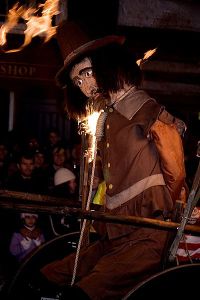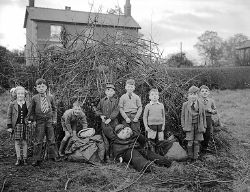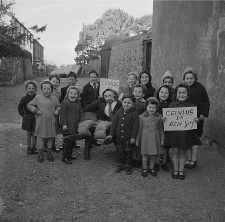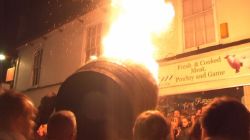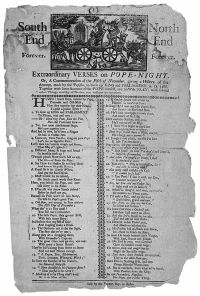Guy Fawkes Night
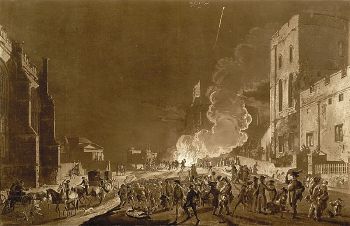
Guy Fawkes Night, also known as Guy Fawkes Day, Bonfire Night, and Firework Night, is an annual commemoration observed on the 5th of November, primarily in the United Kingdom. It began with the events of November 5, 1605 when Guy Fawkes, a member of the Gunpowder Plot, was arrested while guarding explosives the plotters had placed beneath the House of Lords. Celebrating the fact that King James I had survived the attempt on his life, people lit bonfires around London. Some months later, the introduction of the Observance of 5th November Act enforced an annual public day of thanksgiving for the plot's failure.
Within a few decades, Gunpowder Treason Day, as it was known, became the predominant English state commemoration, but as it carried strong Protestant religious overtones it also became a focus for anti-Catholic sentiment. Puritans delivered sermons regarding the perceived dangers of popery, while during increasingly raucous celebrations common folk burnt effigies of the pope and other hate-figures. Towards the end of the eighteenth century, the focus shifted to burning effigies of Guy Fawkes and the 5th of November gradually became known as Guy Fawkes Day. Changing attitudes resulted in the toning down of much of the anti-Catholic rhetoric, and in 1959 the Observance of 5th November Act was repealed. The violence diminished, and by the twentieth century Guy Fawkes Day had become an enjoyable social event where children and families gathered to enjoy a bonfire and set off fireworks. The present-day Guy Fawkes Night is usually celebrated at large organized events, centered on a bonfire and extravagant fireworks displays.
Origins
Guy Fawkes Night originates from the Gunpowder Plot of 1605, a failed conspiracy by a group of provincial English Catholics to assassinate the Protestant King James I of England and replace him with a Catholic head of state. This was to be accomplished by blowing up the Houses of Parliament during the State Opening, which would also kill most of the Protestant aristocracy. In the immediate aftermath of the 5th of November arrest of Guy Fawkes, caught guarding a cache of explosives placed beneath the House of Lords, James's Council allowed the public to celebrate the king's survival with bonfires, so long as they were "without any danger or disorder." This made 1605 the first year the plot's failure was celebrated.[1] The following January, days before the surviving conspirators were executed, Parliament passed the Observance of 5th November Act, commonly known as the "Thanksgiving Act." It was proposed by a Puritan Member of Parliament, Edward Montagu, who suggested that the king's apparent deliverance by divine intervention deserved some measure of official recognition, and kept the 5th of November free as a day of thanksgiving while at the same time making attendance at Church mandatory.[2]
Little is known about the earliest celebrations. In settlements such as Carlisle, Norwich, and Nottingham, corporations (town governments) provided music and artillery salutes. Canterbury celebrated the 5th of November in 1607 with 106 pounds (48 kg) of gunpowder and 14 pounds (6.4 kg) of match, and three years later food and drink was provided for local dignitaries, as well as music, explosions, and a parade by the local militia. Even less is known of how the occasion was first commemorated by the general public, although records indicate that in the Protestant stronghold of Dorchester a sermon was read, the church bells rung, and bonfires and fireworks lit.[2]
Early significance
A study of the earliest sermons preached on this day demonstrates an anti-Catholic concentration "mystical in its fervor."[1] Delivering one of five 5th of November sermons printed in A Mappe of Rome in 1612, Thomas Taylor spoke of the "generality of his [a papist's] cruelty," which had been "almost without bounds."[2] Such messages were also spread in printed works like Francis Herring's Pietas Pontifica (republished in 1610 as Popish Piety), and John Rhode's A Brief Summe of the Treason intended against the King & State, which in 1606 sought to educate "the simple and ignorant ... that they be not seduced any longer by papists."[2]
By the 1620s, the Fifth was honored in market towns and villages across the country, though it was some years before it was commemorated throughout England. Gunpowder Treason Day, as it was then known, became the predominant English state commemoration. Some parishes made the day a festive occasion, with public drinking and processions. Concerned though about James's pro-Spanish foreign policy, the decline of international Protestantism, and Catholicism in general, Protestant clergymen who recognized the day's significance called for more dignified and profound thanksgivings each 5th of November.[3][4]
What unity English Protestants had shared in the plot's immediate aftermath began to fade when in 1625 James' son, the future Charles I, married the Catholic Henrietta Maria of France. Puritans reacted to the marriage by issuing a new prayer to warn against rebellion and Catholicism, and on the 5th of November that year, effigies of the pope and the devil were burnt.[5] During Charles' reign Gunpowder Treason Day became increasingly partisan. Bonfire Night, as it was occasionally known,[4] assumed a new fervor during the events leading up to the English Interregnum. Although Royalists disputed their interpretations, Parliamentarians began to uncover or fear new Catholic plots. Preaching before the House of Commons on the 5th of November 1644, Charles Herle claimed that Papists were tunneling "from Oxford, Rome, Hell, to Westminster, and there to blow up, if possible, the better foundations of your houses, their liberties and privileges."[3]
Following Charles I's execution in 1649, the country's new republican regime remained undecided on how to treat the 5th of November. Unlike the old system of religious feasts and state anniversaries it survived, but as a celebration of parliamentary government and Protestantism, and not of monarchy.[4] Commonly the day was still marked by bonfires and miniature explosives, but formal celebrations resumed only with the Restoration, when Charles II became king. Courtiers, High Anglicans and Tories followed the official line, that the event marked God's preservation of the English throne, but generally the celebrations became more diverse. By 1670 the 5th of November had been turned into a fire festival, attacking not only popery but also "sobriety and good order."[3]
The burning of effigies continued in 1673 when Charles' brother, the Duke of York, converted to Catholicism. In response, accompanied by a procession of about 1,000 people, an effigy of the Whore of Babylon, bedecked with a range of papal symbols, was set on fire. Similar scenes occurred over the following few years. Violent scenes in 1682 forced London's militia into action, and to prevent any repetition the following year a proclamation was issued, banning bonfires and fireworks.[2]
Fireworks were also banned under James II, who became king in 1685. Attempts by the government to tone down Gunpowder Treason Day celebrations were, however, largely unsuccessful, and some reacted to a ban on bonfires in London (born from a fear of more burnings of the pope's effigy) by placing candles in their windows, "as a witness against Catholicism."[4] When James was deposed in 1688 by William of Orange—who, importantly, landed in England on the 5th of November—the day's events turned also to the celebration of freedom and religion, with elements of anti-Jacobitism. While the earlier ban on bonfires was politically motivated, a ban on fireworks was maintained for safety reasons, "much mischief having been done by squibs."[4]
King William III's birthday fell on November 4, according to the Julian calendar, and for orthodox Whigs the two days therefore became an important double anniversary.[6] William ordered that the thanksgiving service for the 5th of November be amended to include thanks for his "happy arrival" and "the Deliverance of our Church and Nation."[7] In the 1690s he re-established Protestant rule in Ireland, and the Fifth, occasionally marked by the ringing of church bells and civic dinners, was consequently eclipsed by his birthday commemorations.
Later developments
From the eighteenth century, the 5th of November celebrations became sectarian in nature. The celebration in Northern Ireland remained controversial, unlike in Scotland where bonfires continued to be lit in various cities.[8] In England though, as one of 49 official holidays, for the ruling class the 5th of November became overshadowed by events such as the birthdays of Admiral Edward Vernon, or John Wilkes. Under George II and George III, with the exception of the Jacobite Rising of 1745, it was largely "a polite entertainment rather than an occasion for vitriolic thanksgiving."[3] For the lower classes, however, the anniversary was a chance to pit disorder against order, a pretext for violence and uncontrolled revelry.
At some point, for reasons that are unclear, it became customary to burn Guy Fawkes in effigy, rather than the pope. Gradually, Gunpowder Treason Day became Guy Fawkes Day. In 1790 The Times reported instances of children "begging for money for Guy Faux,"[3] and a report from November 4, 1804 described how "a set of idle fellows ... with some horrid figure dressed up as a Guy Faux" were convicted of begging and receiving money, and committed to prison as "idle and disorderly persons."[2] The Fifth became "a polysemous occasion, replete with polyvalent cross-referencing, meaning all things to all men."[3]
Lower class rioting continued, with reports in Lewes of annual rioting, intimidation of "respectable householders,"[9] and the rolling through the streets of lit tar barrels. In Guildford, gangs of revelers who called themselves "guys" terrorized the local population; proceedings were concerned more with the settling of old arguments and general mayhem, than any historical reminiscences.[3] Similar problems arose in Exeter, originally the scene of more traditional celebrations. In 1831 an effigy was burnt of the new Bishop of Exeter Henry Phillpotts, a High Church Anglican and High Tory who opposed Parliamentary reform, and who was also suspected of being involved in "creeping popery." A local ban on fireworks in 1843 was largely ignored, and attempts by the authorities to suppress the celebrations resulted in violent protests and several injured constables.[2]

On several occasions during the nineteenth century The Times reported that the tradition was in decline, being "of late years almost forgotten," but in the opinion of historian David Cressy, such reports reflected "other Victorian trends," including a lessening of Protestant religious zeal—not general observance of the Fifth.[3] Civil unrest brought about by the union of the Kingdoms of Great Britain and Ireland by the Acts of Union 1800 resulted in Parliament passing the Roman Catholic Relief Act 1829, which afforded Catholics greater civil rights, continuing the process of Catholic Emancipation in the two kingdoms.
The traditional denunciations of Catholicism had been in decline and were thought by many, including Queen Victoria, to be outdated,[4] but the pope's restoration in 1850 of the English Catholic hierarchy gave renewed significance to the 5th of November, as demonstrated by the burning of effigies of the new Catholic Archbishop of Westminster Nicholas Wiseman, and the pope. At Farringdon Market 14 effigies were processed from the Strand and over Westminster Bridge to Southwark, while extensive demonstrations were held throughout the suburbs of London.[2] Effigies of the 12 new English Catholic bishops were paraded through Exeter, already the scene of severe public disorder on each anniversary of the Fifth.[2] Gradually, however, such scenes became less popular. With little resistance in Parliament, the thanksgiving prayer of the 5th of November contained in the Anglican Book of Common Prayer was abolished, and in March 1859 the Anniversary Days Observance Act repealed the Observance of 5th November Act.[1]
As the authorities dealt with the worst excesses, public decorum was gradually restored. The sale of fireworks was restricted, and the Guildford "guys" were neutralized in 1865, although this was too late for one constable, who died of his wounds.[4] Violence continued in Exeter for some years, peaking in 1867 when, incensed by rising food prices and banned from firing their customary bonfire, a mob was twice in one night driven from Cathedral Close by armed infantry. Further riots occurred in 1879, but there were no more bonfires in Cathedral Close after 1894.[2] Elsewhere, sporadic instances of public disorder persisted late into the twentieth century, accompanied by large numbers of firework-related accidents, but a national Firework Code and improved public safety in most cases brought an end to such things.[4]
Modern traditions
One notable aspect of the Victorians' commemoration of Guy Fawkes Night was its move away from the centers of communities, to their margins. Gathering wood for the bonfire increasingly became the province of working-class children, who solicited combustible materials, money, food, and drink from wealthier neighbors, often with the aid of songs. Most opened with the familiar "Remember, remember, the fifth of November, Gunpowder Treason and Plot."[4]
Organized entertainments also became popular in the late nineteenth century, and twentieth-century pyrotechnic manufacturers renamed Guy Fawkes Day as Firework Night. Sales of fireworks dwindled somewhat during the First World War, but resumed afterwards. At the start of the Second World War celebrations were again suspended, resuming in November 1945.
For many families, Guy Fawkes Night became a domestic celebration, and children often congregated on street corners, accompanied by their own effigy of Guy Fawkes.[2] This was sometimes ornately dressed and sometimes a barely recognizable bundle of rags stuffed with whatever filling was available. Collecting money was a popular reason for their creation, the children taking their effigy from door to door, or displaying it on street corners. But mainly, they were built to go on the bonfire, itself sometimes comprising wood stolen from other pyres, "an acceptable convention" that helped bolster another November tradition, Mischief Night.[10] Rival gangs competed to see who could build the largest bonfire, sometimes even burning the wood collected by their opponents. In 1954 the Yorkshire Post reported on fires late in September, a situation that forced the authorities to remove latent piles of wood for safety reasons.[11] However, in more recent times the custom of begging for a "penny for the Guy" has almost completely disappeared.[2]
In contrast, some older customs still survive; in Ottery St Mary men chase each other through the streets with lit tar barrels,[4] and since 1679 Lewes has been the setting of some of England's most extravagant 5th of November celebrations, the Lewes Bonfire.[9]
Generally, modern 5th of November celebrations are run by local charities and other organizations, with paid admission and controlled access. In 1998 an editorial in the Catholic Herald called for the end of "Bonfire Night," labeling it "an offensive act."[12] Author Martin Kettle, writing in The Guardian in 2003, bemoaned an "occasionally nannyish" attitude to fireworks that discouraged people from holding firework displays in their back gardens, and an "unduly sensitive attitude" toward the anti-Catholic sentiment once so prominent on Guy Fawkes Night.[13]
In other countries
Gunpowder Treason Day was exported by settlers to colonies around the world, including members of the Commonwealth of Nations such as Australia, New Zealand, Canada, and various Caribbean nations. The day is still marked in Saint Vincent and the Grenadines, and in Saint Kitts and Nevis, but a fireworks ban by Antigua and Barbuda during the 1990s reduced its popularity in that country.[14] In Australia, Sydney (founded as a penal colony in 1788) saw at least one instance of the parading and burning of a Guy Fawkes effigy in 1805, while in 1833, four years after its founding, Perth listed Gunpowder Treason Day as a public holiday.[15] By the 1970s, Guy Fawkes Night had become less common in Australia. Some measure of celebration remains in New Zealand, Canada, and South Africa.[14]
In North America the commemoration was at first paid scant attention, but the arrest of two boys caught lighting bonfires on the 5th of November 1662 in Boston, founded in 1630 by Puritan settlers led by John Winthrop, suggests that "an underground tradition of commemorating the Fifth existed."[2] In parts of North America it was known as Pope Day, celebrated mainly in colonial New England, but also as far south as Charleston, South Carolina.
Pope Night in Boston was an occasion for drinking, rioting, and anti-elite protest by the working class. Gang violence became part of the tradition in the 1740s, with residents of different Boston neighborhoods battling for the honor of burning the pope's effigy. By the mid-1760s these riots had subsided, and as colonial America moved towards the American Revolution (1765-1783), the class rivalries of Pope Night gave way to anti-British sentiment. The passage in 1774 of the Quebec Act, which guaranteed French Canadians free practice of Catholicism in the Province of Quebec, provoked complaints from some Americans that the British were introducing "Popish principles." Such fears were bolstered by opposition from the Church in Europe to American independence, threatening a revival of Pope Day. Commenting in 1775, George Washington was less than impressed by the thought of any such resurrections, and forbade any under his command from participating.[2]
Generally, following Washington's complaint, American colonists stopped observing Pope Day, although according to The Bostonian Society some citizens of Boston celebrated it on one final occasion, in 1776.[16] The tradition continued in Salem as late as 1817,[17] and was still observed in Portsmouth, New Hampshire, in 1892.[18]
Notes
- ↑ 1.0 1.1 1.2 Antonia Fraser, The Gunpowder Plot: Terror and Faith in 1605 (Orion Pub. Co., 2004, ISBN 0753814013).
- ↑ 2.00 2.01 2.02 2.03 2.04 2.05 2.06 2.07 2.08 2.09 2.10 2.11 2.12 2.13 James Sharpe, Remember, Remember: A Cultural History of Guy Fawkes Day (Harvard University Press, 2005, ISBN 0674019350).
- ↑ 3.0 3.1 3.2 3.3 3.4 3.5 3.6 3.7 David Cressy, "The Fifth of November Remembered." In Roy Porter (ed), Myths of the English (Blackwell Publishers, 1992, ISBN 0745608442).
- ↑ 4.0 4.1 4.2 4.3 4.4 4.5 4.6 4.7 4.8 4.9 Ronald Hutton, Stations Of The Sun (Oxford University Press, 2001, ISBN 0192854488).
- ↑ Mark Nicholls, The Gunpowder Plot Oxford Dictionary of National Biography, September 22, 2005. Retrieved September 19, 2019.
- ↑ Lynda Pratt (ed.), Robert Southey and the Contexts of English Romanticism (Routledge, 2006, ISBN 0754630463).
- ↑ Lois G. Schwoerer, "Celebrating the Glorious Revolution, 1689–1989" Albion 22(1) (Spring 1990):1-20. Retrieved September 20, 2019.
- ↑ Nicholas Rogers, Halloween: From Pagan Ritual to Party Night (Oxford University Press, 2002, ISBN 0195146913).
- ↑ 9.0 9.1 Jim Etherington, Lewes Bonfire Night (SB Publications, 1999, ISBN 185770147X).
- ↑ Ervin Beck, "Children's Guy Fawkes Customs in Sheffield" Folklore (95)(2) (1984): 191-203. Retrieved September 20, 2019.
- ↑ Iona Opie and Peter Opie, The Lore and Language of Schoolchildren (New York Review Books Classics, 2001, ISBN 978-0940322691).
- ↑ Brenda J. Buchanan, et al., Gunpowder Plots: A Celebration of 400 Years of Bonfire Nights (Penguin, 2005).
- ↑ Martin Kettle, The real festival of Britain The Guardian, November 5, 2003. Retrieved September 20, 2019.
- ↑ 14.0 14.1 John Paul Davis, Pity for The Guy: A Biography of Guy Fawkes (Peter Owen Publishers, 2010, ISBN 0720613493).
- ↑ Government Notice The Perth Gazette and Western Australian Journal, April 27, 1833. Retrieved September 20, 2019.
- ↑ George Washington Expresses Surprise 5th of November in Boston. Retrieved September 20, 2019.
- ↑ Lauren Berlant, The Anatomy of National Fantasy: Hawthorne, Utopia, and Everyday Life (University of Chicago Press, 1991, ISBN 0226043770).
- ↑ John Albee, "Pope Night in Portsmouth, N. H." The Journal of American Folklore (19)(5) (October–December 1892): 335–336. Retrieved September 20, 2019.
ReferencesISBN links support NWE through referral fees
- Berlant, Lauren. The Anatomy of National Fantasy: Hawthorne, Utopia, and Everyday Life. University of Chicago Press, 1991. ISBN 0226043770
- Buchanan, Brenda J. et al. Gunpowder Plots: A Celebration of 400 Years of Bonfire Nights. Penguin, 2005.
- Davis, John Paul. Pity for The Guy: A Biography of Guy Fawkes. Peter Owen Publishers, 2010. ISBN 0720613493
- Etherington, Jim. Lewes Bonfire Night. SB Publications, 1999. ISBN 185770147X
- Fraser, Antonia. The Gunpowder Plot: Terror and Faith in 1605.Orion Pub. Co., 2004. ISBN 0753814013
- Hutton, Ronald. Stations Of The Sun. Oxford University Press, 2001. ISBN 0192854488
- Nicholls, Mark. The Gunpowder Plot Oxford Dictionary of National Biography, September 22, 2005. Retrieved September 19, 2019.
- Porter, Roy. Myths of the English. Blackwell Publishers, 1992. ISBN 0745608442
- Pratt, Lynda (ed.). Robert Southey and the Contexts of English Romanticism. Routledge, 2006. ISBN 0754630463
- Rogers, Nicholas. Halloween: From Pagan Ritual to Party Night. Oxford University Press, 2002. ISBN 0195146913
- Sharpe, James. Remember, Remember: A Cultural History of Guy Fawkes Day. Harvard University Press, 2005. ISBN 0674019350
- Underdown, David. Revel, Riot and Rebellion: Popular Politics and Culture in England 1603-1660. Oxford University Press, 1986. ISBN 0198227957
External links
All links retrieved September 23, 2019.
- Guy Fawkes and Bonfire Night
- Guy Fawkes Day: A Brief History
- Everything you need to know about Guy Fawkes Night
Credits
New World Encyclopedia writers and editors rewrote and completed the Wikipedia article in accordance with New World Encyclopedia standards. This article abides by terms of the Creative Commons CC-by-sa 3.0 License (CC-by-sa), which may be used and disseminated with proper attribution. Credit is due under the terms of this license that can reference both the New World Encyclopedia contributors and the selfless volunteer contributors of the Wikimedia Foundation. To cite this article click here for a list of acceptable citing formats.The history of earlier contributions by wikipedians is accessible to researchers here:
The history of this article since it was imported to New World Encyclopedia:
Note: Some restrictions may apply to use of individual images which are separately licensed.

